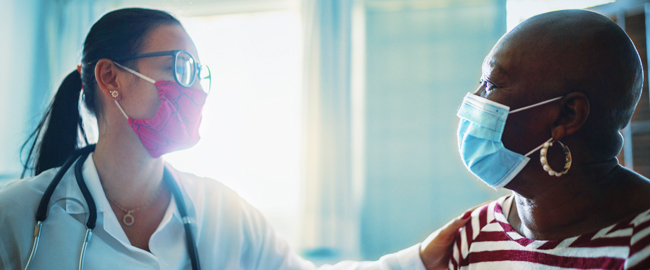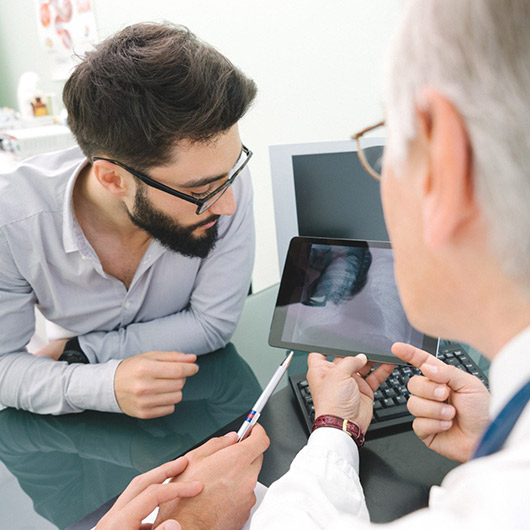Accurate Diagnosis of Lung Cancer
Your doctor may order tests if lung cancer is suspected. We always start with the least invasive way to rule out other conditions. Hackensack Meridian Health offers the most advanced imaging and laboratory testing. Our expert thoracic radiologists and pathologists specialize in identifying and diagnosing lung cancer.
John Theurer Cancer Center is designated as a Lung Cancer Screening Center of Excellence by the Lung Cancer Alliance. We specialize in spiral CT scanning, which can detect many lung cancers in their earlier, more curable stages before you even have symptoms.
Learn more about lung cancer screening and if you are at high risk for lung cancer. Call 844-HMH-WELL (844-464-9355) to make an appointment.- CT: A CT scan creates detailed, 3D images of the inside of the lung to identify the smallest lesions not seen on X-ray. Sometimes, contrast dye is used to highlight the tumor.
- X-ray: A suspicious area in the lung may appear on an X-ray. However, a CT scan is needed to differentiate a benign nodule from a possible tumor.
- Biomarkers: Your blood and urine may be tested to look for biomarkers or other signs of cancer.
- Sputum Cytology: If you have a productive cough, a sample can be looked at under a microscope for cancer cells.
Biopsy is the only way to diagnose lung cancer and determine its type. You’re in good hands with an experienced team using the most advanced technology – including robotic bronchoscopy – at Hackensack Meridian Health.
A biopsy may be taken one of several ways:
- Bronchoscopy: The doctor places a thin, lighted scope down the throat and into the lung. The area is examined with a small camera and a tissue sample is removed. This is done under general anesthesia in less than an hour. You go home the same day.
- Needle biopsy: A needle is passed under image guidance through the chest wall into the lung. A sample of tumor tissue is removed for testing. This is done with local anesthesia in less than an hour. You go home the same day.
- Robotic Bronchoscopy: We’ve taken bronchoscopy to the next level by offering robotic bronchoscopy. The doctor controls the robot’s arm that holds the fiberoptic bronchoscope. The benefits of robotic bronchoscopy include:
- Medical team can view the process while the robot holds the tools.
- Allows for easier navigation within the lungs.
- Greater dexterity and range of motion for hard-to-reach spots.
- Advanced camera technology with high-resolution images.
Lung cancers are categorized into one of two major types – small cell or non-small cell lung cancer. About 80 percent of people with lung cancer have non-small cell.
There are three main types of non-small cell lung cancer:
- Adenocarcinoma: Most common type of lung cancer – about 30 percent of all lung cancer. Forms in cells in the outer lung that produce mucus.
- Large-cell Undifferentiated Carcinoma: Can be found anywhere in the lungs and usually grows and spreads quickly.
- Squamous Cell: Usually found in one of the main air tubes or in the center of the lung where the air tubes join the trachea.
Lung cancers are categorized into one of two major types – small cell and non-small cell lung cancer. Small cell lung cancer is the less common of the two. This type of lung cancer is seen primarily in heavy smokers and can be more aggressive.
There are two main types of small cell lung cancer:
- Combined Small Cell Carcinoma: Also known as mixed small cell/large cell carcinoma
- Small Cell Carcinoma
We treat other kinds of cancers in the lungs and chest, including:
- Carcinoid Tumors: Located in a large airway, typically slow growing.
- Mesothelioma: Found in the lining of the lungs, typically develops decades after exposure to asbestos.
Once your lung cancer has been diagnosed, it is important to determine its stage. Staging tells us the extent of the cancer and helps your care team recommend the best treatment.
- Stage I: Cancer is confined to the lung.
- Stage II and III: Cancer has spread to lymph nodes within the chest.
- Stage IV: Cancer has spread to other parts of the body (metastasized).
Tests to determine the stage of your lung cancer may include:
- CT or MRI
- Endobronchial Ultrasound (EBUS): Similar to a bronchoscopy but with an ultrasound. Biopsies of lymph nodes can be taken.
- Mediastinoscopy: Incision is made at the base of the neck and a camera is inserted under the breastbone to take tissue samples of the lymph nodes.
- PET (positron emission tomography)
Your treatment plan is individualized. It is based on a number of factors, including type and stage of lung cancer, and your health status. It is important to discuss the goals of lung cancer treatment with your doctor.
Surgery
Surgery is still considered the standard for treating early-stage lung cancer. Removing the tumor and surrounding lung tissue margin gives the best chance for cure when the lung cancer is confined to the lungs. Your surgeon removes the lung cancer with a margin of healthy tissue. This may be performed by robotic-assisted surgery or video-assisted thoracic surgery (VATS). Surgical resection of lung cancer is generally performed as:
- Lobectomy: removal of an entire lobe of the lung (there are three lobes on the right and two on the left). Most common surgery performed for lung cancer.
- Pneumonectomy: Removal of an entire lung.
- Segmentectomy: remove a large portion of the lung but not the entire lobe
- Wedge Resection: removing a small piece of the lung that contains the tumor
If you have a larger lung cancer or it has spread from the lungs, your doctor may recommend chemotherapy or radiation.
Chemotherapy
Chemotherapy uses drugs to kill cancer cells. It may be given intravenously through a vein or taken orally. Chemotherapy can be used before surgery to shrink the tumor (for larger tumors), or it can be used after surgery to kill any remaining cancer cells.
Radiation Therapy
Radiation therapy used x-rays and protons to kill cancer cells. It is usually used in combination with chemotherapy for locally advanced lung cancer. It can also be used for focused therapy (stereotactic body radiotherapy), where there is maximum effect on the cancer cells with minimal injury to normal, healthy lung tissue. This type of radiation is usually used in people who have small lung cancers who can't undergo surgery.
Targeted Drug Therapy
Targeted drug therapy focuses on specific gene abnormalities present within cancer cells, causing them to die.









